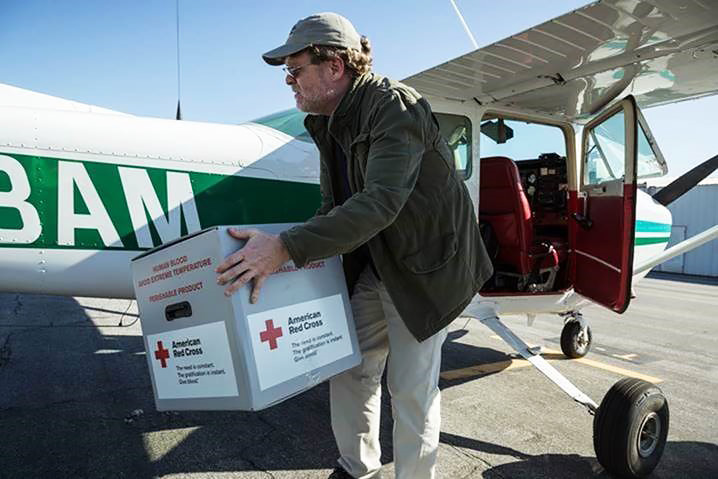California pilots organizing disaster airlift teams
Santa Monica volunteers hold emergency-response exercise
Here’s the scenario: A powerful earthquake has struck the Los Angeles Basin, causing widespread devastation. The Pacific Coast Highway is closed to traffic, and I-405 and I-10 are impassable with collapsed overpasses blocking the roadways.
Airports have not been spared damage, but thanks to the utility of general aviation aircraft, the 2,000 feet of runway left undamaged at the Santa Monica Municipal Airport spotlights the airport’s designation as “critical infrastructure” for the emergency response.
That’s how it might go, say emergency managers, when the next big one strikes. So with a 60-percent probability that an earthquake of magnitude of 6.7 will occur in the Los Angeles region within 30 years, according to the U.S. Geological Survey, local emergency responders conducted a disaster-preparedness exercise in Santa Monica on Jan. 14, assuming crippling damage and a severe public need for medicine, food, and shelter.
“This is a practical demonstration of the City of Santa Monica ‘All Hazards Mitigation Plan’ which lists SMO as ‘Critical Infrastructure’ in a disaster,” said a joint announcement from the Santa Monica Airport’s DART and the American Red Cross.
It was an outstanding exercise, said Paul Marshall, DART chapter coordinator for the California Pilots Association, who flew his Bonanza in for the new Santa Monica disaster airlift response team’s mobilization. For a first exercise, the Santa Monica DART “just hit the ball out of the park,” he said.
Eleven airplanes flew to Santa Monica from Whiteman Municipal Airport, Van Nuys Airport, Brackett Field in La Verne, Compton/Woodley Airport, and Zamperini Field in Torrance.

Flight operations went smoothly despite flying in the vicinity of the famously complex Los Angeles Class B airspace that provides “a lot of opportunities to screw up,” Marshall said, adding, “This is the kind of flying that pilots in the L.A. basin do every day. Any private pilot could fill in and do just fine.”
The Santa Monica mobilization is the latest example of volunteer DARTs moving forward in California. In 2014, the AOPA Foundation awarded a $10,000 Giving Back grant to the South County Airport Association (SCAPA) DART for its work to fine-tune the logistics and communications plans that would be activated in a disaster. The group has received two honorable mentions from the Federal Emergency Management Agency in emergency preparedness contests.
The California Pilots Association noted the work being done by SCAPA at the San Martin Airport, where Marshall and Rod Pharis co-chair the disaster response unit. CalPilots asked Marshall to manage a program to build a statewide network of disaster airlift relief teams.
Ed Story, CalPilots Region 5 vice president, recalled that Marshall attended a CalPilots annual meeting and set up a table to promote disaster response airlifts.
“It occurred to me that CalPilots should sponsor what he was doing,” said Story, who credited Dave Hopkins of the Santa Monica Airport Disaster Airlift Response Team for embracing the DART concept and working with the participating outlying airports on the event. Santa Monica tower controller Tammy Jackson served as operations director and her husband Sean, a Southwest Airlines captain, helped organize the event.
“It was impressive, if I do say myself,” Story said in an email.

With DARTs recently operational in Santa Monica and Watsonville, other disaster response units are being developed by pilot associations at Half Moon Bay Airport, Lincoln Regional Airport, Concord, Torrance, and Napa County, Marshall said.
It was the response of pilots to the magnitude 6.9 Loma Prieta earthquake of 1989—which killed more than 60 people and injured thousands—that inspired Marshall, Pharis, and their colleagues to discuss in 2008 and stage in 2013 a first exercise of the SCAPA Disaster Airlift Response Team in San Martin, SCAPA says on its website.
With Watsonville and Santa Cruz cut off by land after the Oct. 17, 1989, temblor, an “ad hoc airlift” flew 500,000 pounds of food and supplies into the stricken area in the days following the quake that occurred on a long-quiet segment of the San Andreas fault.
Marshall would like to see pilots all around the nation participating in organized disaster responses.
“Disasters are local problems managed by local emergency response managers. As they get overwhelmed, they go up the food chain. They should be able to call upon local pilots operating from local airports,” he said. A template for starting a DART is available on the CalPilots website.
To qualify to fly for a California DART, pilot must hold a private pilot certificate or higher, have liability insurance of at least $100,000 per seat, and be able to fly as pilot in command under CFR Part 91, he said.

Mobilizations are typically coordinated with the local emergency response infrastructure. On hand at Santa Monica was a representative from the Community Emergency Response Team, a program funded by FEMA, Marshall said.
Beyond the probability of a magnitude 6.7 quake, the U.S. Geological Survey also sees a 31- percent probability that an earthquake measuring magnitude 7.5 will occur in the Los Angeles area within 30 years. (An increase of one whole number on the Richter scale, the most commonly used of several measures, “corresponds to the release of about 31 times more energy than the amount associated with the preceding whole number value.”)
Marshall was pleased with the number of aircraft participating in the “small-scale simulation” in Santa Monica. He counsels new DARTs that once a disaster response unit is functional, it should hold regular practice exercises.
“Exercise the machinery about once a year or so, so you stay current,” he said.




